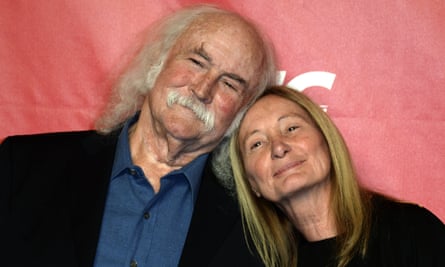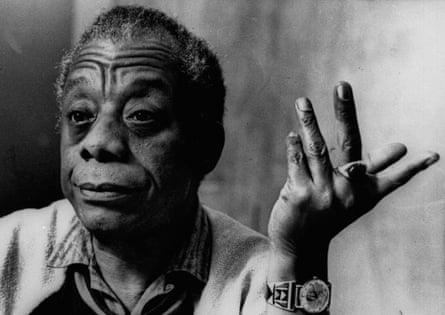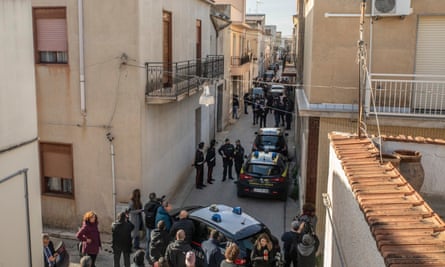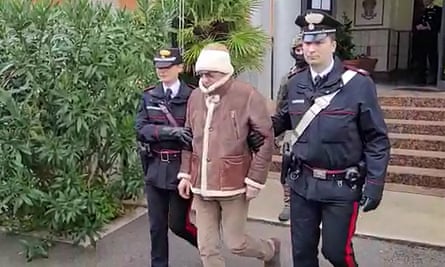[ad_1]
David Crosby, who has died aged 81, was a premier-league rock’n’roll star twice. In the mid-1960s he was a founder member of the Byrds, the Los Angeles band often credited with inventing the genre “folk-rock”. This was defined by their shimmering recording of Bob Dylan’s Mr Tambourine Man, its distinctive harmonies and chiming 12-string guitar carrying it to the top of the charts in Britain and the US in 1965.
Arrogant and argumentative, Crosby was sacked from the Byrds in 1967, but, after producing Joni Mitchell’s debut album, Song to a Seagull, he found an ideal berth with Crosby, Stills and Nash. It was a group of distinct individuals who wrote their own songs, but together they created one of the great harmony-singing blends in pop history. Their debut album, Crosby Stills & Nash (1969), was an immediate smash, and proved hugely influential on a rising generation of west coast artists. Crosby’s long hair, walrus moustache and buckskin jacket made him look like a frontiersman for the Age of Aquarius. Their second album, Déjà Vu (1970), with the addition of Neil Young, and the band becoming Crosby, Stills, Nash and Young (CSNY), felt like the crowning moment of a California golden age. It topped the US chart, reached No 5 in the UK and has sold 14m copies.
The members then embarked on solo ventures and their reunions grew increasingly rare, though they reformed for a stadium tour in 1974, a lavishly wasteful affair that Crosby nicknamed “the Doom tour”. A major obstacle was that Crosby, a regular marijuana and LSD user, would succumb to a ferocious addiction to crack cocaine, with near-fatal consequences. This came to a head on 28 March 1982, when he was arrested by the California Highway Patrol after he crashed his car into the central divider on the Interstate 405 highway. Police found freebasing paraphernalia and a .45-calibre pistol in the car, and it was later determined that Crosby had suffered a seizure from “toxic saturation”.
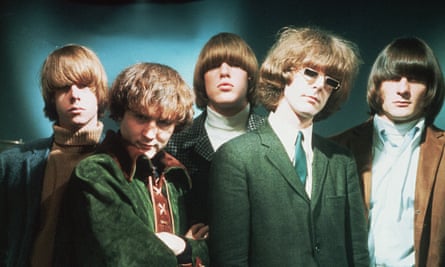
A couple of weeks later he was arrested again on similar charges, this time at a Dallas nightclub where he was performing. A spell in a rehab facility in New Jersey failed when Crosby fled the premises. His decline from prince of west coast rock aristocracy to struggling addict was halted only when he was jailed in Texas in 1986, following yet another drugs-and-firearms arrest.
In 1985, Spin magazine had told its readers “The Tragic Story of David Crosby’s Living Death”, but after being paroled from Huntsville prison in August 1986, Crosby staged a remarkable comeback. He marked his return with the enthralling autobiography Long Time Gone (1988) and the solo album Oh Yes I Can (1989). He would make six further solo discs, in addition to Crosby & Nash (2004), two albums with Stills and Nash (Live It Up in 1990 and After the Storm, 1994) and American Dream and Looking Forward with CSNY (1988 and 1999). In 1987 he married Jan Dance, who had survived her own addiction purgatory alongside him. Shortly after being diagnosed with hepatitis C, in 1994 he underwent a liver transplant, the operation paid for by Phil Collins (Crosby had sung on Collins’s 1989 hit Another Day in Paradise), and bounced back with renewed energy.
Born in Los Angeles, he was the second son of the cinematographer Floyd Crosby and his first wife, Aliph Van Cortlandt Whitehead, a scion of the influential Van Cortlandt dynasty. Floyd came from an upper-class New York background, his father having been the treasurer of the Union Pacific Railroad, and his mother the daughter of a renowned surgeon. He had tried his hand at banking in New York before working on documentary films in the South Pacific (including FW Murnau’s Tabu, for which he won an Oscar) and eventually moving to Hollywood, where he won a Golden Globe award for his work on Fred Zinnemann’s western High Noon and made numerous films with Roger Corman.
David’s early musical influences included classical music and jazz as well as the Everly Brothers and bluesman Josh White, and he recalled how he would take the harmony parts when the family would gather to sing extracts from The Fireside Book of Folk Songs. A trip with his mother to hear a symphony orchestra “was the most intense experience I can remember from my early life” (as he wrote in Long Time Gone), because it illustrated how musicians could collaborate “to make something bigger than any one person could ever do”.
He attended the exclusive Crane school in Montecito, California, then Cate boarding school in Carpinteria. Though intelligent, he regarded academic work with contempt and refused to apply himself. One area where he did shine was in musical stage shows, such as his performance as the First Lord of the Admiralty in Gilbert and Sullivan’s HMS Pinafore. He subsequently attended Santa Barbara City College, but quit and moved to LA to study acting. However, music was becoming his true focus, and he began playing in folk clubs with his elder brother Ethan (who would take his own life in 1997). When a girlfriend became pregnant, Crosby hastily left town and worked his way across the country towards the folk-singing mecca of Greenwich Village, New York, where the likes of Peter, Paul and Mary, Phil Ochs and Joan Baez were breaking through, while Dylan was about to transform the musical climate entirely.
Crosby formed a partnership with the Chicago-born folk singer Terry Callier and they performed frequently together, before Crosby travelled down to Florida in 1962 to sample the folk scene in Miami’s Coconut Grove district. He then worked his way back to Los Angeles via Denver, Chicago and San Francisco. In LA he met Jim (later Roger) McGuinn and Gene Clark, all of them fascinated by the Beatles and the idea of mixing folk with rock’n’roll. They became the Jet Set, which evolved into the Byrds with the addition of the bassist Chris Hillman and drummer Michael Clarke.
Signed to Columbia, the Byrds had already built an enthusiastic local following by playing in clubs such as Ciro’s on Sunset Strip by the time Mr Tambourine Man was released in April 1965, and its success was followed up by their debut album, released in June. Crosby’s distinctive tenor voice was integral to the band’s vocal blend, and he began to develop an idiosyncratic songwriting style.
Influenced by jazz as much as rock, his songs used unusual chords and unconventional melodies. On the band’s third album, Fifth Dimension (1966), one of his most significant contributions was co-writing Eight Miles High. This psychedelic milestone gave them a Top 20 US hit, and also reflected Crosby’s infatuation with the jazz saxophonist John Coltrane. Their next album, Younger Than Yesterday (1967), featured Crosby’s ethereal Everybody’s Been Burned as well as his self-indulgent sound experiment Mind Gardens, while the song Why reflected his admiration for the sitar maestro Ravi Shankar. When the Byrds met the Beatles, Crosby’s enthusiasm for Shankar helped spark George Harrison’s interest in Indian music.
Crosby’s green suede cape and Borsalino hat had made him a Hollywood Hills style icon, but his days as a Byrd were numbered. He had irked his bandmates at the Monterey pop festival in June 1967 by making rambling speeches about LSD and the assassination of John F Kennedy, and also by getting on stage with Stills’s band Buffalo Springfield in place of the absent Young. Crosby’s song Lady Friend (1967) flopped as a single, and during the making of the album The Notorious Byrd Brothers he was fired after arguments over the choice of material. His song Triad, depicting a menage-a-trois, was vetoed by his bandmates as being too risque (Jefferson Airplane subsequently recorded it). Nonetheless, Crosby played on and co-wrote several tracks, and The Notorious Byrd Brothers is arguably the Byrds’ finest album.
Borrowing $25,000 from Peter Tork of the Monkees, Crosby bought a 74ft schooner called Mayan, where he would write some of his best-known songs including Crosby, Stills and Nash’s Wooden Ships. The obvious potential of CSN immediately won them a deal with Atlantic Records, which released their debut album in May 1969. Their second-ever live appearance was at the Woodstock festival that August. Though dominated by the all-round wizardry of Stills, the album showcased the different writing skills of each member. Crosby’s Guinnevere demonstrated his fondness for unusual scales and harmonies, while the bluesy Long Time Gone was a heartfelt response to the assassination of Bobby Kennedy and indicated the group’s willingness to embrace political and social issues.
Déjà Vu, released nine months later, brought another strong showing from Crosby. The hanging chords and mysterious time changes of his title track made it one of his most mesmerising compositions, while Almost Cut My Hair was his battle cry for the counterculture. However, personality clashes within the group while on tour in 1970 prompted them to split.
All the members made solo albums, including Crosby’s If I Could Only Remember My Name (1971). Additionally, he formed a successful duo with Nash, which brought them US Top 10 hit albums with Graham Nash David Crosby (1972, also UK No 13) and Wind on the Water (1975), and they reached No 26 with Whistling Down the Wire (1976). In 1973 Crosby reunited with his previous band for the album Byrds, and in 1977 Crosby, Stills and Nash released CSN, which reached No 2 on the US album chart and outsold the trio’s debut. However, by the time they made Daylight Again (1981), another US Top 10 hit, Crosby was in the throes of addiction. Allies (1983), a patchwork of live and studio material, was the group’s last effort before he was jailed.
Crosby’s post-prison renaissance continued with regular tours with CSN, who went on the road almost annually from 1987, with Young joining them in 2000, 2002 and 2006. He released the solo album Thousand Roads (1993), which gave him a minor hit single with Hero, then picked up the pace dramatically in the new century with Croz (2014), Lighthouse (2016), Sky Trails (2017) and Here If You Listen (2018). For Free, featuring Steely Dan’s Donald Fagen and Michael McDonald, came out in 2021. His final release, in December, was David Crosby & the Lighthouse Band Live at the Capitol Theatre.
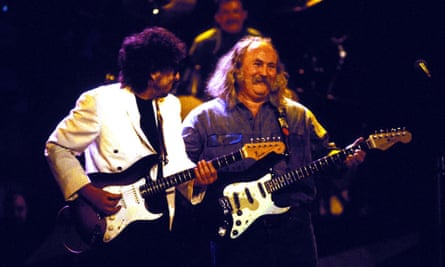
One of his regular musical collaborators was James Raymond, his child with Celia Crawford Ferguson, whom Crosby had left pregnant in California in the early 60s, and who had given her baby up for adoption. She later moved to Australia. Raymond met his birth mother in 1994, then in 1995 introduced himself to his biological father at UCLA medical centre, where Crosby was having treatment following his liver transplant. An accomplished musician and composer, Raymond played in the jazz-rock band CPR with his father and Jeff Pevar (they released four albums between 1998 and 2001), was music director for Crosby’s solo live shows and also became a member of Crosby, Stills and Nash’s touring band from 2009.
Yet Crosby’s creative rebirth coincided with a calamitous breakdown in relations with his old comrades. In 2014 Young said CSNY would never tour again after Crosby described his new partner, Daryl Hannah, as “a purely poisonous predator”, and in 2016 Nash, who had always gone the extra mile for Crosby throughout his addiction years, also announced his estrangement from him.
In 1991 Crosby was inducted into the Rock and Roll Hall of Fame as a member of the Byrds, and in 1997 with Crosby, Stills and Nash. He won the 2019 Critics’ Choice movie award as the “most compelling living subject of a documentary” for AJ Eaton’s film David Crosby: Remember My Name.
Crosby continued to be plagued by health problems. He suffered from type 2 diabetes, and in 2014 was left with eight stents in his heart following major cardiac surgery.
He was the sperm donor for the children of Melissa Etheridge and her partner Julie Cypher: their son, Beckett, who died in 2020, and daughter, Bailey.
Jan and their son, Django, survive him, as do James, a daughter, Erika, by Jackie Guthrie, and a daughter, Donovan, by Debbie Donovan.
[ad_2]
#David #Crosby #obituary
( With inputs from : www.theguardian.com )





